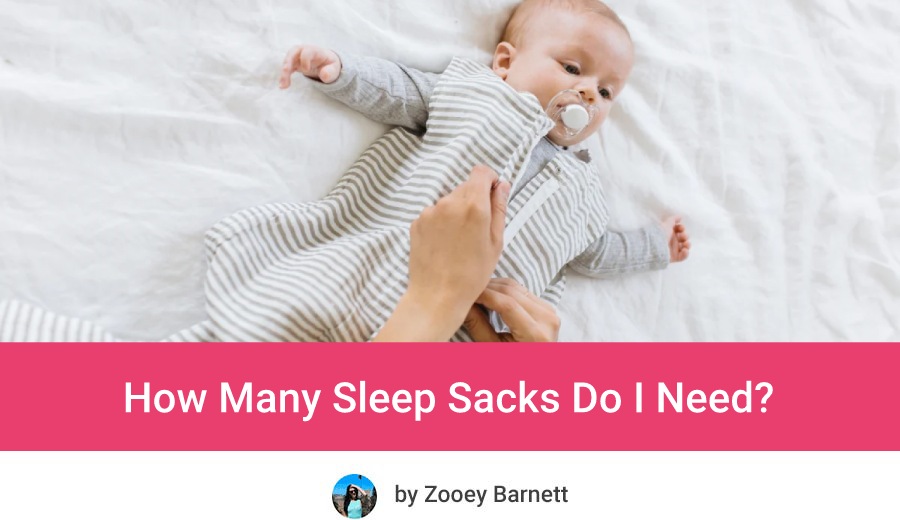
Hello sleep-deprived parents! Are you wondering how many sleep sacks you need for your little one? You’re in the right place! In this article, I’m gonna share my tips for deciding how many sleeping sacks you should buy (or register for) for your child. I’ll also show you different types of sleep bags, their benefits, and how to use them in a safe way. So, let’s get started!
This article is not a substitute for medical advice.
What Is A Sleep Sack?
Sleep sack is a type of wearable blanket that zips up and keeps your little one warm and snug while they sleep. It is designed to use for babies and toddlers, and it is perfect for chillier nights, but it can also come in handy during summer (there are many fantastic sleep sacks for warm weather).
Sleep sacks provide the perfect balance of warmth and breathability, and come in a variety of sizes, fabrics, and colors to suit your growing child’s needs.
Sleeping bags can be made from various types of fabrics which makes them suitable for different seasons and temperature. To choose the right one, you need to check the TOG rating what temperature it is recommended for, and how to dress up your baby properly for the sleep sack.
It zips up so your child can’t kick it off. Sleep sack help babies stay warm without the worries of loose blankets that can cover their face.
It also helps to keep your baby’s startle reflex under control. Unlike regular blankets, sleep sacks are designed to prevent your baby from awaking up themselves due to the startle reflex.
The best sleep sacks are made from stretchy fabrics and provide ample space for baby’s legs and hip for natural movement during the night.
With a sleep sack, your little one can stay warm and safe, and you’ll both be able to enjoy a peaceful and restful sleep.
How Is A Sleep Sack Different From A Swaddle?
A sleep sack is a great way to keep your baby warm and secure without the need to swaddle them. A swaddle is typically used for babies up to 3 months of age (who cannot roll over yet) and keeps them in a snug, womb-like position.
This is the biggest difference from sleep sacks which can be used from newborn stage even up to toddlerhood (depending on the size of the specific bag). Moreover, they keep the child warm and secure, but still allow them to move their legs freely (later on you can also choose a sleeveless sleep sack that keeps baby’s arms free to move).
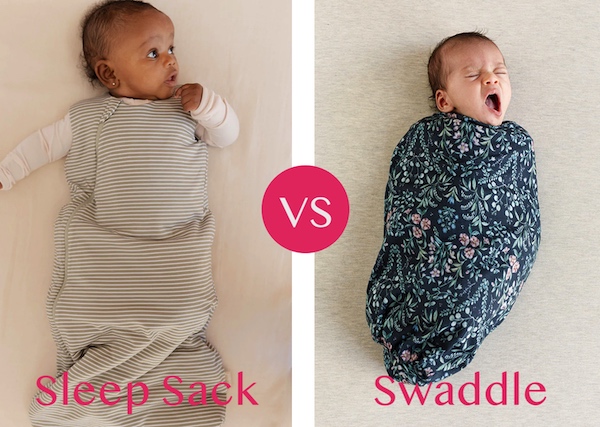
A sleep sack is a fantastic alternative to swaddling your baby. It’s a wearable blanket that keeps your little one comfortably warm and snug without being too restrictive like a traditional swaddle.
It gives your baby the freedom to move and kick, while still keeping them safe and secure. Plus, it’s much easier to use than a swaddle because you don’t have to worry about wrapping the fabric around your baby in a proper way (safe for their hips).
Are There Different Types Of Sleep Sacks?
Yes, absolutely, there are definitely different types of sleep sacks. They are made from various fabrics, suitable for different weather conditions and temperature in baby’s nursery. There are also multiple types of sleeping sacks, designed for babies of different age.
Here’s a list of some of the different types and what they can offer:
Swaddle Sleep Bags
These are designed to keep baby’s arms in and have the top part that looks a bit like a swaddle. Baby’s upper body is kept snuggly as in a swaddle, while their legs are free to move.
These are great for keeping little ones warm and secure while they sleep, and reducing their startle reflex so it doesn’t bother them.
Sleeveless Swaddles
These are designed for slightly older infants who stopped startling. They allow the baby’s arms to move freely while still keeping the baby snug and comfortable at night.
Sleep Bags With Feet
This is option for kids who can already walk. They are also sleeveless, and allow the baby’s legs to move freely, while still keeping them secure. Some of these sleeping bags are convertible and allows to tuck the feet away to keep baby’s feet in and warm at night.
Weighted Swaddles
These are similar to regular swaddle sleep bags, but they have a weighted fabric that, according to manufacturers, provides extra sense of security. However, weighted sleep sacks are not recommended by the AAP and I also advice against using them.
TOG Ratings
sleep bags come with different TOG ratings, which basically refer to the amount of warmth that the bag provides. There are different ratings to suit different seasons and the temperature in your home.
Below you can see the chart with TOG ratings and temperatures they are recommended for.
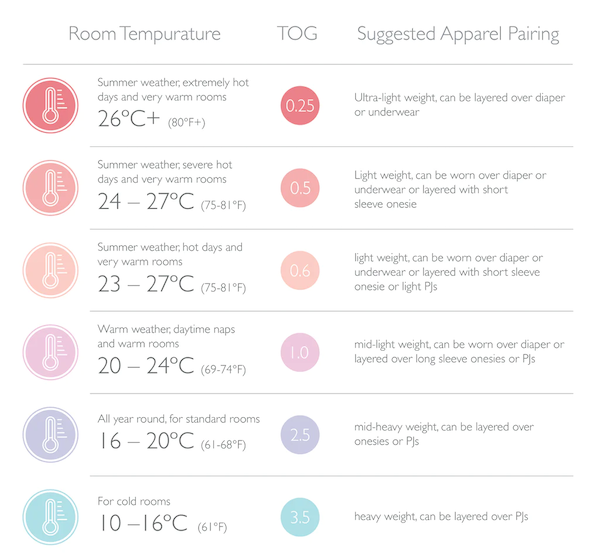
How Many Sleeping Sacks Should I Have?
Having the right sleeping bags for your baby is really important! I would suggest having at least 2-3 sleep bags (for each stage/size and weather).
It’s best to have a few different sleep bags in case of diaper blowouts, leakage or spills. That way you’ll always have a clean, dry sleep bag ready for your baby no matter what happens.
Having a variety of sizes will ensure you are always prepared as your baby grows. A sleep bag that is too small can be uncomfortable or unsafe, while a sleep bag that is too large can be a tripping hazard.
How Many Swaddle Sacks Do I Need?
Swaddle sacks are the type of sleeping sacks that have a wide bottom, and the top part is swaddled snuggly with baby’s arms in. This version is best for newborns and babies up to 3 months.
I would recommend having 2-3 swaddle sacks so you always have a spare one when one is in the laundry and the other one gets dirty from a diaper blowout (yes, this will happen!).
Reasons Why You Need Multiple Sleep Sacks
- Convenience – Having multiple sleep sacks means you always have a spare one, and you don’t have to worry about washing the one you use every night. This saves you time and energy, so you can get some much needed rest.
- Hygiene – Multiple sleep sacks allow you to always have a clean one at hand and change them frequently, so your little one always sleeps in comfy bag (not sweaty or dirty one with breast milk stains).
- Flexibility – With multiple sleep sacks, you can choose the one that suits your baby’s needs depending on the weather. They come in a variety of weights and TOGs, so you can choose one that will keep your baby warm in the winter and cool in the summer.
- More Comfort – Sleep sacks provide an extra layer of comfort and warmth that helps babies sleep more soundly. They are also incredibly soft and cozy, making them perfect for a peaceful night’s rest.
- Variety – Sleep sacks come in a variety of colors, styles and designs. This means you can switch between different ones, to find your baby’s favorite.
Why Should You Use A Sleep Sack? – Benefits
You may be wondering if the sleep sacks are actually a must-have or maybe you can just skip buying them and get a blankie for your little one?
According to safe sleep recommendations by AAP, baby’s sleep surface should be empty – no blankets, pillows and other fluffy stuff that would pose a suffocation hazard.
If you’re worried that your baby will get chilly at night (maybe you live in a cold place?), or you want to prevent your little one from startling and crying and make them sleep through the night more peacefully, then sleep sack (aka wearable blanket) is the best and safest choice.
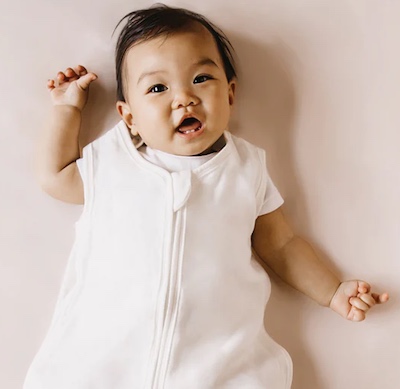
In my opinion there are so many reasons to use sleeping bag:
Keeps Your Baby Safe
A sleep sack provides a safe and secure environment for your baby. It prevents them from slipping under loose blankets, which can be dangerous and lead to SIDS. There’s no loose materials that could ride up over baby’s mouth and pose a suffocation hazard. It also keeps them warm and comfortable throughout the night.
Easy To Put On & Take Off
You don’t have to worry about tying complicated swaddle when you’re trying to get your baby ready for bed. Sleep sacks are easy to slip on and off, making the bedtime routine a breeze.
Promotes Better Sleep For Baby
Sleep sacks are designed to keep your baby at a comfortable temperature all night long. Just choose the right TOG rating for the temperature in baby’s room. When babies feel warm and secure they tent to wake up less. It also helps to reduce startling making it easier for the baby to sleep through the night.
Easy Rolling Over
Sleeveless sleep sacks grow with your baby and support them as they reach next developmental milestones. Babies have freedom of movements and can roll over in the sleep sack, and thanks to having arms out, they can use their arms to support themselves and change position (in contrast to being tightly swaddled in a swaddle with arms in).
Makes Nighttime Diaper Changes Easier
No more fumbling around in the dark trying to find the right snaps. Most sleeping bags have 2-way zippers, so you can easily change your baby’s diaper, and then zip it right back up.
Supports Healthy Hip Development
Sleep sacks are baggy and give babies room to kick their legs and allow their hips move freely, which is good for development of hip joints.
On the other hand, wrapping or swaddling your baby too tightly in a swaddle, reduces hips flexibility and natural movement, and can lead to hip dislocation or hip dysplasia1.
Do Babies Really Need Sleep Sacks?
Some parents wonder if they really need sleep sacks, or maybe they should simply buy a baby blanket and bedding.
Sleep sacks are definitely the safest option, and while they may not be a must-have for your baby, they can certainly be very useful.
Using a sleep sack is much safer than using a blanket, and it can help your baby get a better night’s sleep. If you are worried about your baby becoming too hot or too cold while they sleep, then a sleep sack can help.
Rather than having a blanket that can easily become too heavy and cover baby’s mouth, a sleep sack is lightweight and allows your baby to stay warm without becoming overheated and sweaty, and it always stays in place – it won’t ride up over baby’s face.
Sleep sacks can also help your baby to feel secure and safe, as it will be like a gentle hug around their body. This can help your baby to feel more relaxed and secure and can help them to sleep for longer periods of time.
Sleeping sack can be a great addition to your baby’s sleep routine. It’s much safer than using a blanket, provides extra warmth and comfort, and can help your baby to feel secure and relaxed.
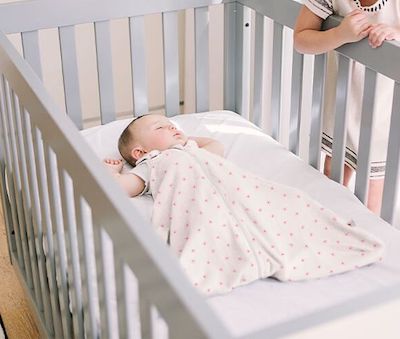
What Age Do Babies Use Sleep Sacks?
Babies can use sleep sacks from newborn stage well into toddlerhood (when they are approx. 3 years old).
When To Start Using A Sleep Sack?
You can start using swaddle sack for newborn baby – with arms tucked in.
Then, when your little one reaches the milestone of rolling over, which usually happens between four and six months of age, you should transition to regular sleeveless sleeping bag. So when baby is 4-6 months old you should use sleeveless wearable blankets (arms out).
As your baby gets older, you can look for sleep sacks with adjustable leg holes to suit your little one better, when they master walking.
How Long Should Sleep Sacks Be Used?
Sleep sacks should be used until your little one is ready to graduate to a regular blanket and bedding. Lots of brands offer large sizes of sleep sacks – even for 3 year olds.
This means that you can use sleep sacks throughout the toddlerhood, just make sure to always choose the right size, so your baby has enough space in the bag for natural movements during the night.
When Should You Stop Using A Sleep Sack?
Baby’s safety is the priority, that’s why you should use sleep sack as long as possible – instead of a loose blanket that can increase the risk of SIDS.
You should use sleep sacks at least until 12 months of age. But you can also find sleep sacks that are safe for toddlers, so you can actually use until your child is 2-3 years old!
You should stop using specific sleep sack when your baby outgrows it – then it’s time to size up. Follow manufacturer age, height and weight recommendations to make sure your little one fits well in their sleep bag.
You can also stop using a sleep sack when your child is old enough to sleep with a regular blanket and bedding – it can be anytime between 12 and 36 months of age (but not sooner than 12 months – as per AAP safety recommendations!).
How To Dress Your Baby Under The Sleep Sack
Depending on the temperature of baby’s room (or your bedroom), as well as the TOG rating of baby’s sleep sack, you’ll want to dress your baby in different layers. You don’t want your baby to get too cold at night, but too much layers is a risk of sweating and overheating which is even more dangerous.
If you’re unsure how to dress your baby under the sleep sack, check the chart below. You’ll find out if you should choose PJs, onesies or keep the baby just in a diaper under the sleeping sack.
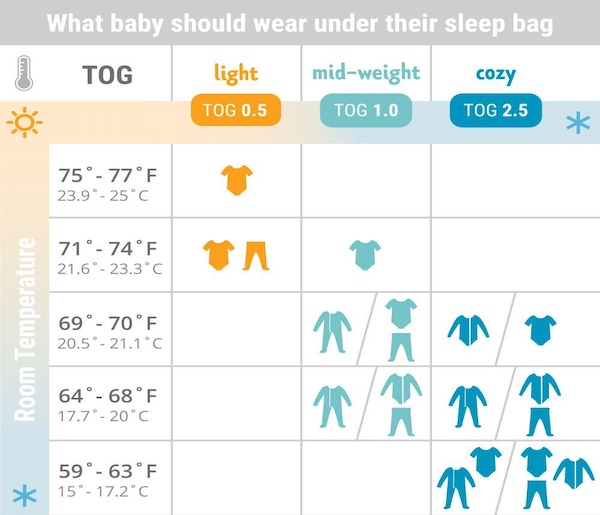
Do Babies Need Sleep Sacks In Summer?
Yes, babies need sleep sacks in summer too. There are many benefits of using sleeping bags in warmer months – but you need to choose proper ones made from breathable fabric, and with lower TOG rating (ideally TOG 0.5 or lower).
This way your baby won’t get overheated or sweaty, but still feel snuggly which gives the sense of security and help to sleep more peacefully throughout the night.
Are Sleep Sacks Safe For Babies That Can Roll Over?
Yes, sleep sacks are safe for babies that can roll over. At this stage baby needs a sleeveless sleep sack (or a bag that keeps their arms out) to be able to support themselves and easily change the position during the night.
This is the biggest difference between swaddles and sleep sacks. Swaddles that keep baby’s arms tucked in, are no longer safe for babies who can already roll over and should stop using them once your baby reaches this milestone.
This is the time to transition to sleeveless sleeping sack that allows baby’s arms move freely – they are safe for babies who can roll over on their own.
Can Babies Sleep On Their Stomachs In A Sleep Sack?
According to AAP recommendations, babies under 12 months of age should only sleep on their back, regardless of sleeping in a wearable blanket or not. This is the safest position, because it reduces the risk of suffocation and SIDS.
If the baby is at least 1 year old, he/she can start sleeping in different positions, including sleeping on stomach.
Are Weighted Sleep Sacks Safe For Babies?
Let me say it loud and clear: According to safe sleep guidelines by AAP, weighted sleep sacks are NOT safe for babies2.
Of course manufacturers of weighted sleep sacks say that they are perfectly safe and the weight is evenly distributed and designed to be light enough to not restrict movement or cause discomfort. But the truth is weighted blanket can be incredibly unsafe for your baby and AAP advices against using weighted swaddles, sleepers and blankets or even placing them anyway near a sleeping baby.
The biggest concern about weighted sleep sacks is that its weight can constrict baby’s chest movements, leading to the lack of oxygen. Another danger of using weighted sleeping sacks is that it can lead to overheating which is also a risk factor for SIDS3. Moreover, while in the weighted sleep sack, baby may get into unsafe sleeping position and be unable to get out of this position, which is extremely dangerous!
There’s one more reason you should not use weighted blankets: there is no adequate evidence that would show weighted swaddles or blankets dramatically improve baby’s sleep (SO WHY WOULD YOU RISK IT?!).
The purpose of this article is informative. It’s not a substitute for professional medical advice or medical care. Remember: safety first! Consult your doctor/pediatrician in case of any doubts. The author of this article does not accept any responsibility for any liability, loss or risk, personal or otherwise, incurred as a consequence, directly or indirectly, from any information or advice contained here.
References:
https://health.clevelandclinic.org/sleep-sack-safety/
https://hipdysplasia.org/infant-child/faq-infant-child-hip-dysplasia/
https://rednose.org.au/news/weighted-baby-sleep-sack-warning-from-red-nose-in-lead-up-to-red-nose-day-on-friday-12-august
https://hechingerreport.org/cracking-down-on-unsafe-infant-sleep-products/
https://publications.aap.org/pediatrics/article/150/1/e2022057990/188304/Sleep-Related-Infant-Deaths-Updated-2022?autologincheck=redirected
Picture at the top created from a picture that belongs to Little Unicorn Brand (https://littleunicorn.com/)

